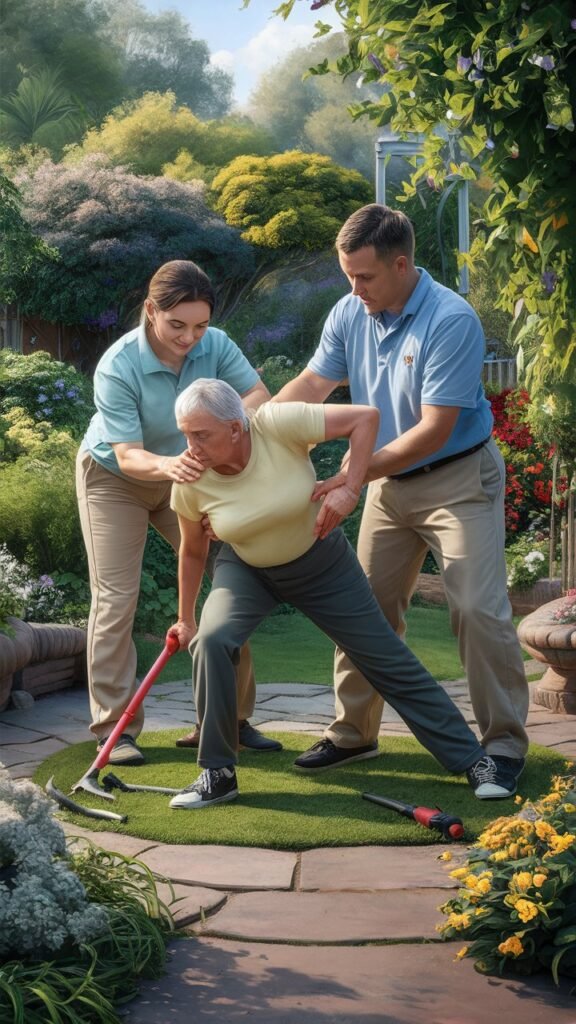Have you ever felt the gentle embrace of nature and wished you could capture that sense of peace and healing in your own backyard? Creating a garden for healing and rehabilitation is a rewarding journey that can significantly enhance your physical and mental well-being.
Understanding the Healing Power of Gardens
Gardens are not just about growing plants; they are about cultivating a space where you can reconnect with nature, find solace, and rejuvenate your body and mind. The idea of therapeutic gardens dates back to ancient times when monks cultivated gardens in monasteries to aid in the healing process. Today, the concept has evolved into an essential component of physical therapy and rehabilitation programs.
The Benefits of a Therapeutic Garden
Therapeutic gardens have been scientifically proven to offer a plethora of benefits. Let’s explore some of these advantages:
Physical Rehabilitation: Gardening tasks such as digging, planting, and watering provide gentle physical exercise that can improve mobility, strength, and coordination. These activities also offer a low-impact workout that is perfect for people recovering from injuries or surgeries.
Mental Health: The soothing ambiance of a garden can reduce stress, anxiety, and depression. The act of tending to plants and watching them grow gives a sense of purpose and accomplishment.
Cognitive Function: Gardening encourages problem-solving and planning, which can enhance cognitive abilities. This is especially beneficial for individuals recovering from brain injuries or strokes.
Social Interaction: If you’re involved in a community garden, it provides an excellent opportunity to interact with others, fostering a sense of community and reducing feelings of isolation.
Designing Your Healing Garden
Creating a therapeutic garden involves thoughtful planning to ensure that it meets your specific needs. Here’s how you can get started:
Assess Your Space and Needs
Before you start digging, take a moment to evaluate the space you have and what you want to achieve with your garden. Consider the following factors:
Space: Whether you have a spacious backyard or a small balcony, you can create a healing garden. The key is to optimize the space you have.
Accessibility: Your garden should be easily accessible, especially if you have mobility issues. Raised beds or container gardens can be ideal for those who find it challenging to bend or kneel.
Purpose: Identify what you want to gain from your garden. Is it a space for meditation, physical therapy, or social interaction? Your goals will influence the design and elements you incorporate.
Choosing the Right Plants
The selection of plants is crucial for a therapeutic garden. Opt for varieties that engage the senses and have therapeutic properties.
Aromatic Plants: Plants like lavender, rosemary, and mint release calming scents that can reduce stress and anxiety.
Colorful Blooms: Bright, colorful flowers such as marigolds, sunflowers, and tulips can uplift your mood and add visual appeal to your garden.
Edible Plants: Growing herbs and vegetables like basil, tomatoes, and lettuce not only provide nutritious food but also give a sense of accomplishment when you harvest them.
Designing for Sensory Stimulation
A therapeutic garden should engage all your senses. Here are some elements to consider:
Sight: Incorporate a variety of colors, shapes, and textures to create visual interest. Add features like water fountains or sculptures to enhance the visual appeal.
Smell: Plant aromatic herbs and flowers that release soothing scents. Consider adding a honeysuckle vine or a patch of lavender to fill the air with a pleasant fragrance.
Touch: Choose plants with different textures, such as the soft leaves of lamb’s ear or the rough bark of a tree. Adding a small sand or pebble path where you can walk barefoot can also stimulate your sense of touch.
Sound: The gentle rustling of leaves or the sound of water can be incredibly calming. Install a small water feature or hang wind chimes to create soothing background noise.
Taste: Edible gardens allow you to engage your sense of taste. Fresh fruits, vegetables, and herbs can be a delightful addition to your meals.

Incorporating Rehabilitation Activities
A healing garden can be a dynamic space where you can engage in various rehabilitation activities. These exercises can be seamlessly integrated into the gardening tasks, making rehab less monotonous and more enjoyable.
Physical Exercises
Stretching Activities: Use gardening tools to help with stretching exercises. For example, reaching for a tool on a high shelf can help stretch your arms and shoulders.
Strengthening Exercises: Tasks like digging, lifting pots, or carrying watering cans can build muscle strength. Ensure you use proper techniques to avoid strain or injury.
Balance and Coordination: Navigating through garden paths, stepping on stones, or bending to pick up fallen leaves can improve your balance and coordination.
Mental and Cognitive Exercises
Memory Exercises: Plan your garden layout and remember where each plant is located. This can help improve your memory and cognitive function.
Problem-Solving Tasks: Encountering and solving issues like pest control or plant diseases can enhance your problem-solving skills.
Mindfulness and Meditation: Dedicate a corner of your garden for meditation. Use this space to practice mindfulness, focusing on the sounds, smells, and sights around you.

Creating Accessibility Features
Your garden should be a place where you feel comfortable and safe. Incorporate accessibility features to ensure that everyone, regardless of physical ability, can enjoy and benefit from the space.
Raised Beds and Container Gardens
Raised beds and container gardens are perfect for individuals with mobility issues. They reduce the need for bending or kneeling and can be positioned at a height that is comfortable for you.
Smooth Pathways
Ensure that the pathways in your garden are smooth and wide enough to accommodate wheelchairs or walkers. Non-slip surfaces can prevent falls and accidents.
Accessible Tools
Use gardening tools designed for people with limited strength or dexterity. Ergonomic tools with soft grips can make gardening easier and more comfortable.
- 5-IN-1 Garden Weeding Trowel: This garden hand weeding tool is specially designed with a fork head. At the front end, ca…
- Robust and Sturdy: The weed remover tool is made of high-hardness polished stainless steel that is extremely resistant t…
- Ergonomic Soft-Grip Handle: Non-slip and comfortable plastic handle is gentle on hands and improves control while reduci…

- Ergonomic Design: Bernini’s Garden Tool Set features a unique vertical grip, providing comfort and ease for all gardener…
- Comprehensive Set: This gardening kit comes with all the essential hand gardening tools you need, including a durable ha…
- Enhanced Power: Engineered to transfer arm strength directly into the tool, these garden hand tools maximize efficiency …
Seating Areas
Include comfortable seating areas where you can rest and enjoy the beauty of your garden. Benches with armrests are ideal as they provide support when getting up or sitting down.

Creating a Garden for All Seasons
A therapeutic garden should be a sanctuary that you can enjoy throughout the year. Plan your garden with all seasons in mind to ensure it remains vibrant and engaging, no matter the weather.
Spring
Spring is a time of renewal and growth. Plant bulbs like daffodils and tulips in the fall so they bloom in the spring. Herbs like basil and cilantro can also be planted as the weather warms up.
Summer
Summer is the season of abundance. Plant sun-loving vegetables like tomatoes, peppers, and zucchini. Ensure your garden has a shaded area where you can relax and avoid the midday sun.
Fall
Fall is perfect for planting cool-weather crops like kale, spinach, and carrots. Add some chrysanthemums and pansies to keep your garden colorful as the temperature drops.
Winter
Winter doesn’t have to mean the end of your gardening activities. Plant evergreens and winter-blooming flowers like hellebores. Set up a bird feeder to attract wildlife, adding life and movement to your garden during the colder months.
Table: Seasonal Plants and Activities
| Season | Plants to Grow | Activities |
|---|---|---|
| Spring | Daffodils, Tulips, Basil, Cilantro | Planting bulbs, Starting seedlings |
| Summer | Tomatoes, Peppers, Zucchini | Watering, Weeding, Harvesting |
| Fall | Kale, Spinach, Carrots, Chrysanthemums | Preparing soil for winter, Planting cool-weather crops |
| Winter | Evergreens, Hellebores | Setting up bird feeders, Pruning |
Engaging with the Community
A therapeutic garden can also be a communal space where you interact with others, share knowledge, and build a support network.
Joining a Community Garden
Community gardens are an excellent way to access a larger gardening space and connect with fellow gardening enthusiasts. These gardens often have shared resources and tools, making them accessible and beneficial for everyone.
Garden Clubs and Workshops
Consider joining garden clubs or attending workshops to learn new gardening techniques and share your experiences. These gatherings can provide valuable knowledge and foster a sense of camaraderie.
Involving Friends and Family
Invite friends and family to participate in your gardening activities. It can be a fun, bonding experience, and their support can be incredibly motivating.
Sustaining Your Garden
Creating a therapeutic garden is just the beginning. Maintaining it requires ongoing effort, but it doesn’t have to be overwhelming.
Regular Maintenance
Weeding and Pruning: Regularly weed and prune your plants to keep them healthy and looking their best. This can also prevent pests and diseases.
Watering and Feeding: Ensure your plants receive adequate water and nutrients. Use organic fertilizers to enrich the soil.
Seasonal Clean-Up: At the end of each season, clean up fallen leaves, dead plants, and debris to prepare your garden for the next phase.
Adapting to Changes
Your needs and physical abilities may change over time. Be open to adapting your garden accordingly. For example, if bending becomes difficult, focus more on container gardening or raised beds.
Seeking Help When Needed
Don’t hesitate to seek help if you find it challenging to maintain your garden. Enlist the assistance of friends, family, or hire a gardener if necessary. The goal is to ensure that your garden remains a source of joy and healing, not a burden.
The Emotional Journey
Creating and nurturing a therapeutic garden is more than just a physical activity; it’s an emotional and spiritual journey. As you cultivate your garden, you’ll likely find that it cultivates you in return, fostering growth, resilience, and inner peace. And be sure to keep a daily journal if you want. I know that for me, I feel a sense of accomplishment with each and every success I make in my garden.
Finding Joy in Small Moments
Celebrate the small victories—whether it’s a new bloom, a bountiful harvest, or simply a moment of tranquility in your garden. These small joys can add up, enhancing your overall sense of well-being.
Embracing Imperfection
Gardens, like life, are imperfect. Plants may die, pests may invade, and weather may be unpredictable. Embracing these imperfections can teach you valuable lessons in patience, resilience, and acceptance.
Connecting with Nature
Spending time in your garden allows you to connect with nature in a profound way. This connection can be grounding and centering, helping you navigate life’s challenges with a sense of peace and stability.
Conclusion
Creating a garden for healing and rehabilitation is a journey filled with growth, both in plants and in your own personal development. This nurturing ground can become a sanctuary where you find physical strength, mental clarity, and emotional peace. By carefully planning your garden, incorporating therapeutic elements, and maintaining it with love and care, you can create a space that heals, rejuvenates, and inspires.
As you embark on this journey, remember that every garden, like every person, has its unique rhythm and pace. Honor that uniqueness, and you’ll find that your garden becomes a reflection of your own healing process. Happy gardening and may your garden bring you the peace and rehabilitation you seek.

My name is Michelle Warren, and I’m the founder of Peaceful Gardening. As a 10-year breast cancer survivor, I’ve discovered the profound therapeutic power of gardening. This journey has not only helped me recover but has also become my passion and a source of ongoing peace and joy.
Peaceful Gardening was born from my desire to share the healing benefits of gardening with others. Whether you’re facing health challenges, dealing with stress, or simply looking to connect more deeply with nature, this space is for you.
Over the past decade, I’ve cultivated not just plants, but a deep understanding of how gardening can positively impact mental health. I’ve worked with local community gardens, led workshops on mindful gardening practices, and collaborated with mental health professionals to develop gardening-based stress reduction programs.
Peaceful Gardening was born from my desire to share the healing benefits of gardening with others. Whether you’re facing health challenges, dealing with stress, or simply looking to connect more deeply with nature, this space is for you.
Here, you’ll find evidence-based advice on using gardening as a tool for mindfulness, stress relief, and emotional healing. I share personal stories, practical tips, and scientifically-backed information on how to create your own therapeutic garden space, no matter the size of your yard or balcony.
My mission is to help you discover the joy, peace, and healing that comes from nurturing plants and connecting with nature. Join me in exploring how the simple act of tending to a garden can transform your mental and emotional wellbeing.
Welcome to Peaceful Gardening – let’s grow together towards better mental health!”


